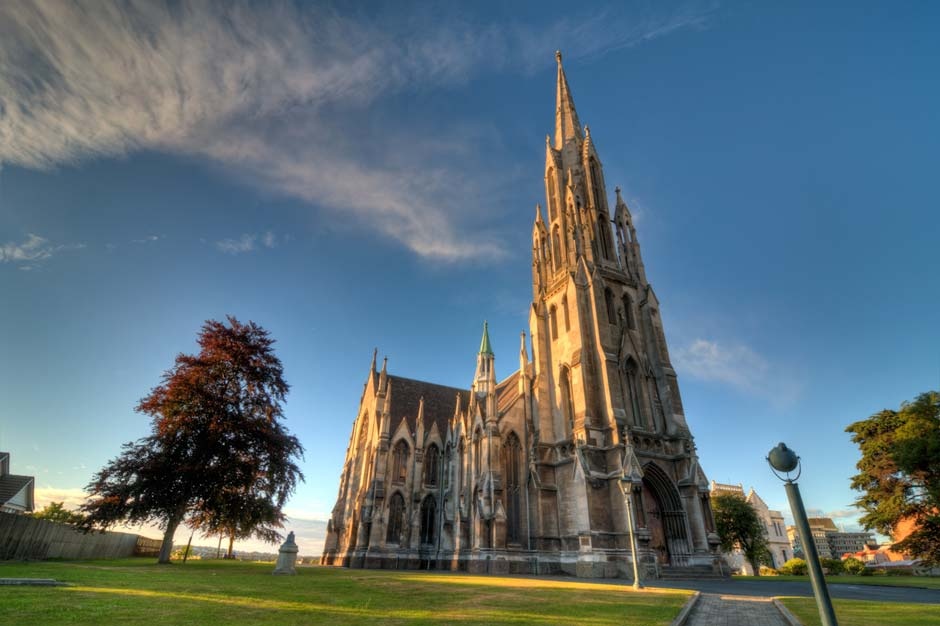
First Church of Otago (1873)
Otago’s semi-theocratic founding fragment
The ‘Old Identity’ tweaked by Frederick Thatcher (see entry 25) had its roots in the ‘disruption’ that split the Church of Scotland in 1843 over the appointment of ministers.
The Free Church of Scotland felt that this was the congregation’s business and no one else’s. The Free Church leaders of New Edinburgh (Dunedin) were high-minded, austere folk, whose settlement was ‘a conscious attempt to yoke together Edward Gibbon Wakefield’s ideal of a class settlement and evangelical mission, as part of a world-wide strategy to defeat Popish ignorance by Protestant truth’. In 1848 Captain William Cargill (1784-1860) and the Reverend Thomas Burns (1796-1871, nephew of the poet), sailed into Otago Harbour aboard the John Wickliffe and the Philip Laing, leading a settlement that was less Scottish, Free Church and godly than they liked to admit. Like many exiles, ‘they lived by their memories, and by their myths, by their heritage of Reformation and Covenant and Disruption, of freedom from Papacy, Prelacy and Patronage, as they like to put it’. Burns and Cargill treated other denominations shamefully by modern standards (they called the Anglicans the ‘Little Enemy’) and tried to police the morals of the community. We would think them narrowminded, but their ‘stern, humourless puritanism’ appealed to the Scots settlers, who as Peter Matheson says, ‘wore their Protestant culture comfortably, like an old baggy suit’.
There is nothing baggy about First Church. Burns believed that faith could move mountains and the provincial government moved a hill to get it here. In 1862, as people and money poured into Otago, the authorities decided to lop 12 m from Bell Hill, an obstruction between the Octagon and the Exchange, to provide fill for harbour reclamation. The project kept hundreds busy for a decade and required the removal of 50 buildings, among them Burns’s brand-new First Church manse. It also delayed the construction of this church, which architect Robert Lawson was preparing to supervise. Still, what First Church lost in splendour it gained in ease of access, for had the hill not been topped, it ‘would have had a setting like the Acropolis, but [one that] would have taxed the devotion of the congregation’. On 15 May 1868 the ailing Burns, the driving force behind this building, finally laid the foundation stone. Lawson’s planned clerestory was abandoned at a late stage of construction, a turret blew down in 1872 and the spire, built 4.5 m too short, had to be dismantled and rebuilt. Yet experts frequently call the building the country’s finest 19th-century structure. Needless to say, some ‘Scotch Kirk’ members thought it too fancy. In 1885 the introduction of hymn singing into services provoked 70 to break away and form the Chalmers Church. In 1887, 49 parishioners voted against adding instrumental music.
Further information
This site is item number 44 on the History of New Zealand in 100 Places list.
Websites
- Heritage New Zealand List entry
- First Church of Otago
- Presbyterian Church – Te Ara
- Thomas Burns biography – Te Ara
- Robert Lawson biography – Te Ara
- Dunedin, Edinburgh of the South - Roadside Stories (video)
Books
- Dennis McEldowney (ed.), Presbyterians in Aotearoa 1840-1990, Presbyterian Church of New Zealand, Wellington, 1990
- Arthur Salmond, First Church of Otago and how it got there, Otago Heritage Books, Dunedin, 1983





Community contributions